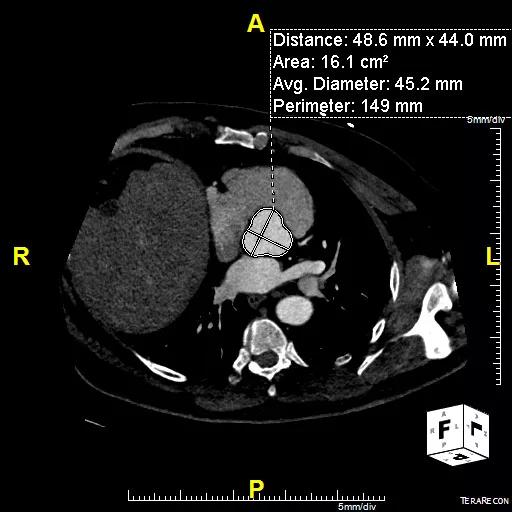Indexing aortic root area to patient height adds prognostic value

Determining when to operate on patients with a dilated proximal ascending aorta and trileaflet aortic valve may have just gotten easier, thanks to a new analysis. The research — a large observational cohort study from Cleveland Clinic — indicates that indexing aortic root area to patient height provides independent and improved stratification for mortality risk as compared with aortic diameter alone.
Cleveland Clinic is a non-profit academic medical center. Advertising on our site helps support our mission. We do not endorse non-Cleveland Clinic products or services. Policy
“There has been controversy about the stage at which we should intervene in these patients,” says cardiologist Milind Desai, MD, corresponding author of the study, which was published in Circulation in late 2016. “Questions have surrounded whether it should be based on when the aorta reaches some absolute diameter or rather reaches a certain size ratio relative to the patient’s height, body mass index or body surface area.”
A 2010 joint guideline document from a number of medical and surgical societies relies on absolute size thresholds, recommending surgery in cases of trileaflet aortic valve with an ascending aortic diameter 5.5 cm or greater for patients with noninherited aortic aneurysms and between 4 and 5 cm in patients with inherited aortopathies.
But these recommendations are based on consensus opinion rather than large outcomes datasets, and observations from the International Registry of Acute Aortic Dissection show that about 40 percent of patients have an aortic diameter less than 5 cm at time of presentation with type A aortic dissection.
The recommendations also fail to account for patient size and sex. “An aortic cutoff size of a 5-foot-2-inch individual is not likely to be the same as the one for a 6-foot-8-inch individual,” notes Dr. Desai, who is also Professor of Medicine at Cleveland Clinic Lerner College of Medicine.
A number of experts have therefore suggested indexing aortic dimensions using patients’ body surface area or height. About 15 years ago, Cleveland Clinic cardiac surgeon and co-author of the new Circulation study Lars Svensson, MD, PhD, proposed the use of a ratio of aortic area to patient height, and he published findings showing that a ratio > 10 cm2/m was associated with aortic dissection in patients with bicuspid aortopathy and Marfan syndrome.

Sample cross-sectional image from a patient with a trileaflet aortic valve and a dilated aortic root. This patient’s ratio of aortic root cross-sectional area to height was 10.4 cm2/m.
“Nevertheless, until now, no large analyses had looked at the incremental prognostic value of this index in the context of a dilated aortic root and ascending aorta in patients with a trileaflet aortic valve,” says Dr. Svensson, Chairman of Cleveland Clinic’s Miller Family Heart & Vascular Institute.
That prompted Drs. Svensson, Desai and colleagues to undertake the new study published in Circulation, which evaluated 771 consecutive patients with trileaflet aortic valve and concomitant aortopathy evaluated at Cleveland Clinic from 2003 to 2007. All patients had:
The ratio of aortic root area over height was calculated for all patients, and a cutoff of > 10 cm2/m (based on the earlier reports mentioned above) was designated abnormal. Patients were followed for a mean of 7.3 ± 2.6 years, during which all-cause death rates were tracked.
“These findings show that an aortic root area/height ratio > 10 cm2/m has significant and independent prognostic value in stratifying risk among patients with trileaflet aortic valve and dilated aorta,” say Drs. Desai and Svensson. “The ratio has a clear role in clinical decision-making.”
Co-author Brian Griffin, MD, Section Head of Cardiovascular Imaging, notes that it remains to be prospectively determined whether the ratio is a better guide than aortic root diameter for deciding when to proceed with surgical repair. “It is notable, however, that almost half the patients in this dataset not meeting the criterion of a diameter greater than 5.5 cm had an abnormally high ratio of aortic root area to height,” he says.
“I suspect that treatment guidelines will eventually change to reflect the prognostic utility of the ratio in this population,” concludes Dr. Desai. In the meantime, he and his Cleveland Clinic colleagues are working on additional studies to improve risk stratification and help with better surgical timing in various aortopathies.

Surprise findings argue for caution about testosterone use in men at risk for fracture

Findings support emphasis on markers of frailty related to, but not dependent on, age
![GettyImages-1252287413 [Converted]](https://assets.clevelandclinic.org/transform/StoryPanel/350804b2-f1e4-4d97-a277-9629cf45af3e/23-HVI-4120348_redlining_650x450_jpg?w=3840&q=75)
Large database study reveals lingering health consequences of decades-old discrimination

Additional analyses of the two trials presented at 2023 ESC Congress

Prospective SPIRIT-HCM trial demonstrates broad gains over 12-month follow-up

An ACC committee issues recommendations to accelerate sluggish progress

Review of our recent experience shows it’s still a safe option

Machine learning may improve risk prediction and guide therapy